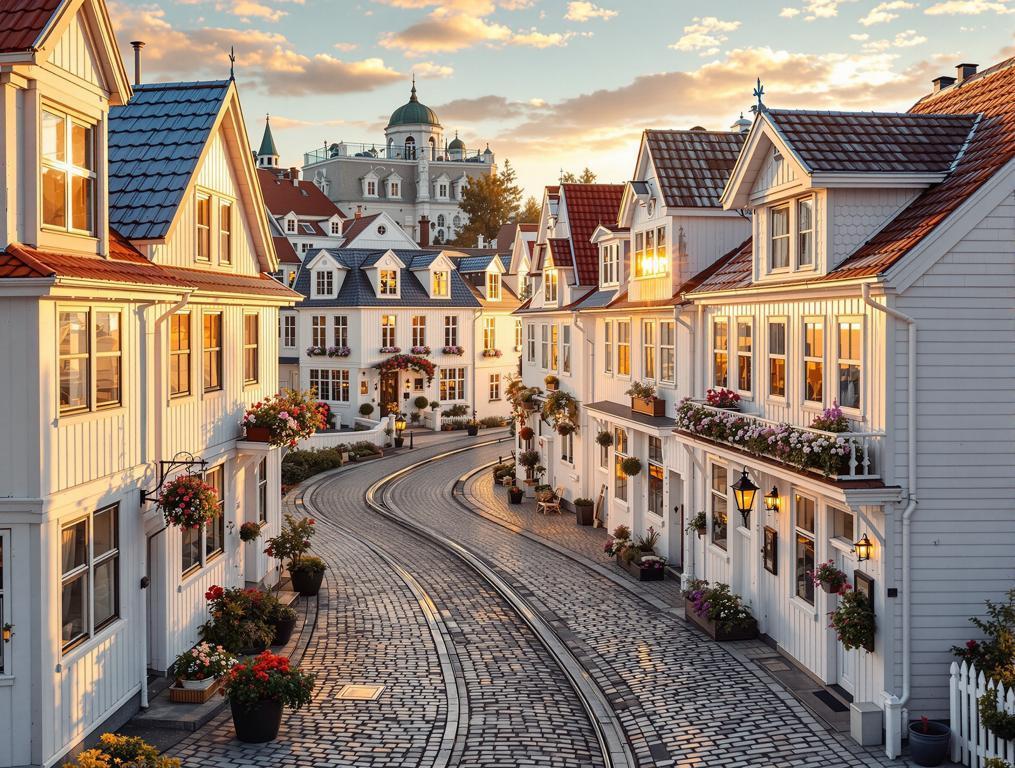I’m standing on the edge of Skudeneshavn’s harbor, where gleaming white wooden houses rise like sentinels against the Norwegian sky. This coastal village of just 3,200 residents holds a secret that even many Norwegians don’t know: over 85% of its old town buildings are perfectly preserved Empire-style wooden houses from the 1800s. Nicknamed “The White Lady of the Empire,” Skudeneshavn sits quietly on Norway’s southwestern Karmøy Island, about 200 kilometers from Bergen, outshining its more famous cousin Gamle Stavanger without making a fuss about it.
Norway’s Hidden White Empire: Where 19th Century Maritime Life Stands Frozen
The morning sun catches on window frames as I wander narrow cobblestone streets where fishermen once hauled their herring catches. Unlike Gamle Stavanger’s more urbanized old town, Skudeneshavn’s historic district feels like stepping directly into a maritime painting.
“We don’t just preserve buildings – we’re preserving a way of life,” a silver-haired shopkeeper tells me as she arranges handcrafted wooden boat models. Eighty to ninety percent of the old town’s structures date from the 1800s herring boom that brought unexpected wealth to this tiny fishing community.
The preservation is remarkable when you consider Norway’s harsh coastal weather. While sipping coffee at Verdens Minste Kafe (literally the “World’s Smallest Café”), I watch summer light play across the tar-coated pine exteriors – a construction technique that separates these buildings from their New England counterparts.
My photographer wife Sarah captures a wooden figurehead known locally as “The Lady in the Park,” one of several unexpected treasures hidden throughout town. The most mysterious is the “moonstone” in Skudeneshavn Park – an 800-million-year-old geological curiosity once mistaken for a meteorite.
Beyond Gamle Stavanger: The Quiet Alternative to Norway’s Tourist Hotspots
Most tourists flock to Bergen or Stavanger’s old quarters, leaving Skudeneshavn blissfully uncrowded. While Gamle Stavanger sees thousands of daily visitors in summer, here I encounter perhaps two dozen tourists all morning, most Norwegian themselves.
“I’ve visited Gamle Stavanger fifteen times and never knew this place existed. It’s like finding the perfect white pearl hidden inside an ordinary oyster – smaller but infinitely more precious.”
The difference isn’t just in visitor numbers. Skudeneshavn maintains working maritime traditions through its annual Skudefestivalen (pronounced “skood-uh-fes-tee-len”), celebrating traditional Norwegian boats and seafaring culture each summer.
Unlike the more commercial feel of Stavanger’s tourist district, shops here remain authentic. At Majorstuen Antikviteter, Johannes and his wife serve homemade waffles with raspberry jam alongside antiques. Locals still use free community rowing boats tied up in the harbor – just take one and explore.
What the Guidebooks Won’t Tell You
For the best experience, arrive via the coastal road from Haugesund (37 kilometers north), where you’ll find free parking near the harbor. The tourism office doesn’t advertise it, but the Bade-Olena swimming area opened in 2021 with a lighthouse-themed sauna bookable for 150 NOK per hour – a perfect end to a summer day.
Visit during early morning (before 10am) to have the streets practically to yourself, or come for golden hour when the white houses glow amber. Locals suggest stopping at the “proposal bench” in the park – legend claims sitting on the “yes” side brings romantic luck.
For a truly unique experience, book an overnight stay at Vikholmen Lighthouse – a secret even most Norwegian travelers haven’t discovered. From there, you’ll see why sailors called this “The White Lady” as the town’s silhouette emerges from morning mist.
As I walk back to the harbor at sunset, I’m struck by how Skudeneshavn embodies what we travelers eternally seek: authenticity without pretense. Like the 800-million-year-old moonstone in the park, some treasures remain hidden in plain sight, waiting for those willing to venture beyond the obvious. Emma will have to wait until she’s older to appreciate the maritime museums, but even at seven, I know she’d love counting the white houses that stand like dominoes along these ancient streets.
